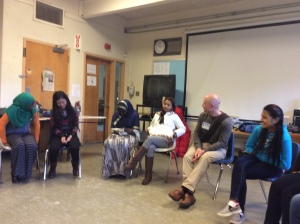So excited about tomorrow’s lesson!
We’re going to CATEGORIZE!
We have been working on learning words for emotions, and now we’re ready to kick it into high gear. We had the smaller group today.
 I found this great graphic this week on the blog A Diary of a Mom. While I was printing off enough copies so each student could have one, Suzy had them sort stuff.
I found this great graphic this week on the blog A Diary of a Mom. While I was printing off enough copies so each student could have one, Suzy had them sort stuff.
They sorted markers BY COLOR.
They sorted coins BY VALUE.
We went through the pictures today and defined the emotions. We only had time to cut them apart.
And we need to teach them to categorize.
I found “categorize” in the Common Core State Standards in 4th grade literature:
CCSS.ELA-LITERACY.W.4.8
Recall relevant information from experiences or gather relevant information from print and digital sources; take notes and
categorize information, and provide a list of sources.
But really what we are working on is a Kindergarten standard:
CCSS.ELA-LITERACY.L.K.5.A
Sort common objects into categories (e.g., shapes, foods) to gain a sense of the concepts the categories represent.
And this eventually leads to a 9th grade standard that focuses on nuances of word meaning:
CCSS.ELA-LITERACY.L.9-10.5.A
Interpret figures of speech (e.g., euphemism, oxymoron) in context and analyze their role in the text.
How sorting common objects eventually morphs into interpreting figures of speech… That’s going to take some investigation. But as far as the skill goes, you’ve gotta start somewhere, though, right???
So our ultimate goal is to get students to sort these emotions. Which is where we will get to tomorrow. And the end goal in this is really grounded in our work with the Center For Mindful Learning: identify emotions that are not helpful in your life and figure out what you can do to deal with these emotions and move yourself in a positive direction.
So here’s what’s on the docket tomorrow with the big group:
 First, we’re going to sort stuff. I just went to Michael’s and bought a ton of little things: shells, rocks beads… and we will sort. We will create a word bank to introduce the idea of “categories.” I am wondering whether we eventually want to get into the word “properties” to move toward a science spin, but for now, we’re going with the Tier 2 vocabulary.
First, we’re going to sort stuff. I just went to Michael’s and bought a ton of little things: shells, rocks beads… and we will sort. We will create a word bank to introduce the idea of “categories.” I am wondering whether we eventually want to get into the word “properties” to move toward a science spin, but for now, we’re going with the Tier 2 vocabulary.
And then we’re going to use a sentence frame to talk about how we sorted things. Maybe we’ll take pictures and use ThingLink to describe our sorts. That will allow us to reinforce our course goal, to move students into more oral proficiency so they can be successful in the mainstream classroom:
How did you sort this? I sorted this by _______________________ (color, shape, size…)
And then we go back to our faces. And we try to sort emotions. We won’t tell them how to sort. We hope eventually to get to positive and negative emotions. But the thought processes are very interesting to watch. How did you sort these? By the emogi’s forehead squiggles? By the way you feel? What categories are you going to use?
This, in turn, is allowing us to start looking into the graduate expectation of creativity. We want our students to be creative thinkers. And maybe by letting them sort on their own terms, they can figure out a little better how they think.
Wish us luck!
 I walked into the room just this morning, saw four boys sitting at the back tables, each glued to his iPad. They had focus all right.
I walked into the room just this morning, saw four boys sitting at the back tables, each glued to his iPad. They had focus all right.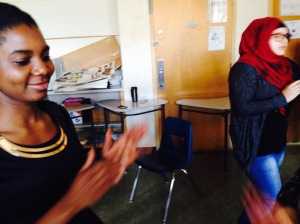
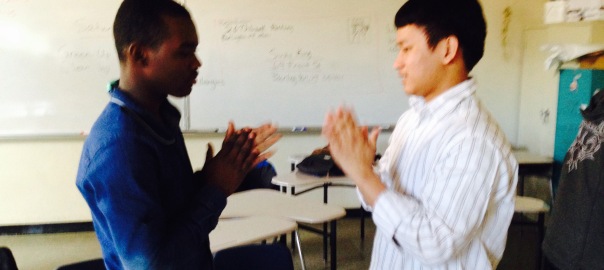







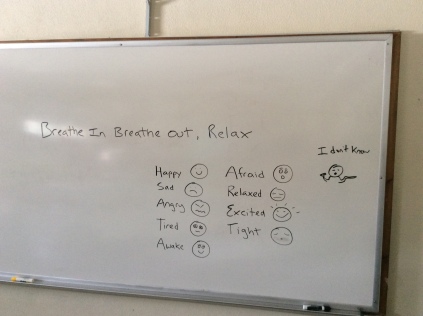
 For the biggest chunk of time, I was having students deal with money. We had tried to play a game called
For the biggest chunk of time, I was having students deal with money. We had tried to play a game called 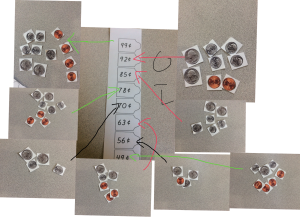 Not when money matters.
Not when money matters.

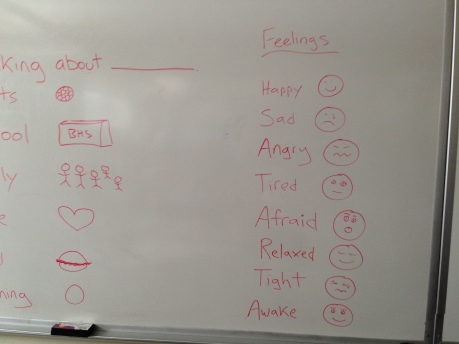 It seems like we are all in such need of mindfulness, of shutting off all those things that are keeping us in a bad space during the day…
It seems like we are all in such need of mindfulness, of shutting off all those things that are keeping us in a bad space during the day… Lindsay was talking to students about things they think about and emotions they feel every day. And then we went through this amazing exercise:
Lindsay was talking to students about things they think about and emotions they feel every day. And then we went through this amazing exercise: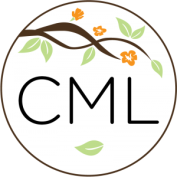
 I have just started the 10-week course from CML that we will be modifying for use with beginning level English Language Learners. I made my daughters breathe with me. Just once.
I have just started the 10-week course from CML that we will be modifying for use with beginning level English Language Learners. I made my daughters breathe with me. Just once.
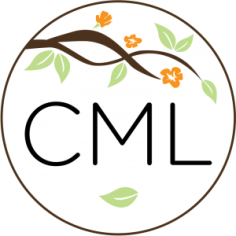


 When we do that, we can bring our tool with us… when we are angry in the car (which I seem to be a lot lately), when we are frustrated in math class, when we are angry at our siblings, when we are anxious about a test… We can use this tool to help us function.
When we do that, we can bring our tool with us… when we are angry in the car (which I seem to be a lot lately), when we are frustrated in math class, when we are angry at our siblings, when we are anxious about a test… We can use this tool to help us function.
 On December 9, Lindsay from Center for Mindful Learning came in. We went through a breathing exercise and then talked about how our bodies felt. We worked on breathing and took turns leading the breathing. We tightened and relaxed.
On December 9, Lindsay from Center for Mindful Learning came in. We went through a breathing exercise and then talked about how our bodies felt. We worked on breathing and took turns leading the breathing. We tightened and relaxed. I found this great graphic this week on the blog
I found this great graphic this week on the blog  First, we’re going to sort stuff. I just went to Michael’s and bought a ton of little things: shells, rocks beads… and we will sort. We will create a word bank to introduce the idea of “categories.” I am wondering whether we eventually want to get into the word “properties” to move toward a science spin, but for now, we’re going with the
First, we’re going to sort stuff. I just went to Michael’s and bought a ton of little things: shells, rocks beads… and we will sort. We will create a word bank to introduce the idea of “categories.” I am wondering whether we eventually want to get into the word “properties” to move toward a science spin, but for now, we’re going with the  Last week,
Last week, 